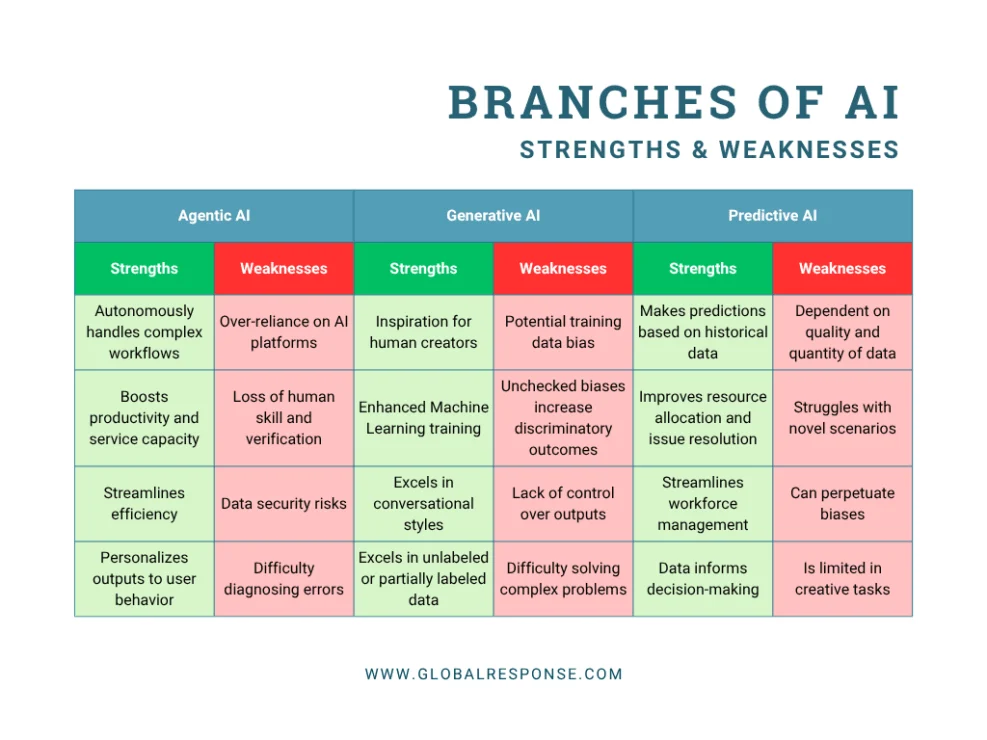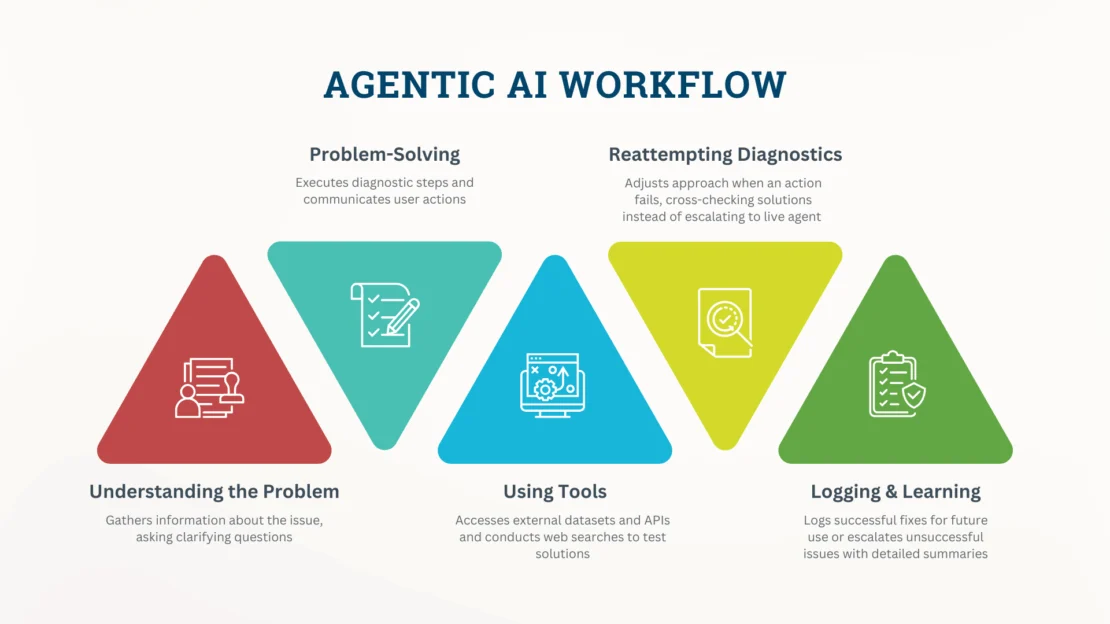Read Time: 14 minutes
What is Agentic AI and Why Does It Matter for Businesses?
Agentic AI is artificial intelligence that acts on its own to set goals and complete multi-step processes without human intervention. Agentic AI is crucial for businesses to adopt because it empowers them to serve more customers without relying on human support.
Table of Contents
Introduction
Artificial intelligence is taking the world by storm, and experts are finding new ways to harness its power for continuous customer and business success. Growing interest in AI pushes innovative minds to look beyond generative models, turning to agentic AI to streamline processes better than ever before. Fully autonomous agentic AI models perform complex tasks without human oversight, presenting an invaluable asset to businesses across industries.
Learn how agentic AI can improve your business by taking a deep dive into the newest development in AI in today’s Global Response blog.
Key takeaways
- Agentic AI enables systems to act independently and complete complex tasks with minimal human supervision.
- Unlike traditional AI, agentic models set goals, reason, adapt, and execute decisions, making them especially useful for automating workflows, decision-making, and optimizing customer service operations at scale.
- In contact centers, agentic AI drives significant improvements in efficiency and customer experience by automating issue resolution, outbound campaigns, lead qualification, real-time coaching, and intelligent routing.
- While agentic AI offers major benefits like scalability, real-time learning, and cost efficiency, it also introduces challenges such as ethical concerns, bias, and integration barriers.
- Businesses must invest in governance, transparent systems, and continuous monitoring to ensure safe, fair, and effective implementation.

What is agentic AI?
Agentic AI is artificial intelligence that accomplishes specific tasks with limited human supervision, building upon generative AI techniques. While generative AI uses Large Language Models to interpret data and create content, agentic AI interprets data to empower models to apply outputs to specific goals.
“Agentic” refers to the model’s agency or capacity to act independently — almost like a human agent, if you’d like to remember it that way. Check out these agentic AI examples to understand what sets it apart from regular AI:
Your chatbot request: “Set a reminder for this task at 9 am.”
Your agentic AI request: “Help me plan my week.” The agentic AI model finds free time in your calendar and automatically organizes your schedule with events, tasks, and reminders.
Chatbot asks for and validates order numbers and directs customers to a standard return process.
Agentic AI can verify order details, check the company’s return policy and product value, generate a return label, process the replacement order or refund, and update back-end systems.
How agentic AI works
Learning what is agentic AI can open your mind to the benefits, challenges, uses, and future of agentic AI. Agentic AI agents are machine learning (ML) models designed to mimic human decision-making. This enables them to reason, make plans, solve problems and complete complex tasks.
These key components of the agentic AI learning process empower automated decision-making.
- Perception: The AI collects data through sensors, APIs, databases, or user interactions.
- Reasoning: The AI processes data using Natural Language Processing (NLP) and computer vision to interpret queries, detect patterns, and understand context.
- Goal setting: The model sets objectives based on predefined goals or user inputs and develops a strategy to achieve them through decision trees, reinforcement learning, or planning algorithms.
- Decision-making: AI agents use probability models, utility functions, or machine learning-based reasoning to evaluate potential actions and choose the best one.
- Execution: The AI implements the action in external systems to interact with users.
- Adaptation: The model gathers feedback to evaluate the success of the action and improve performance.
- Orchestration: Platforms coordinate the automation of the AI system, agents, and workflows, tracking progress, managing resource usage, monitoring data flow, and handling failures.
How agentic AI differs from traditional AI
While agentic AI uses similar processes and building blocks that make up traditional AI models, agentic AI utilizes a few extra processes to operate autonomously where traditional AI operates within predefined constraints, relying primarily on human input for verification, refinement, and permissions.
For example, to complete the above process, agentic AI uses closed-loop learning to gather and analyze feedback for self-refinement and improvement. This enhances performance over time based on real-time feedback.
Traditional models, by contrast, don’t always use closed-loop learning and use passive data assimilation or manual annotation to improve language and behavior learning. They excel in repetitive actions such as sorting data, filtering spam, or providing recommendations.
The bottom line: Agentic AI exhibits autonomous, goal-driven behavior and adaptability while traditional models operate in strict boundaries and struggle with unexpected changes.
Agentic AI vs. generative AI vs. predictive AI
Agentic, generative, and predictive models are distinct branches of artificial intelligence that can be used for various purposes to streamline business processes or improve user engagement. Let’s review each to understand their functions, strengths, and weaknesses for peak performance.
Agentic AI: Autonomous decision-making
Strengths: Handles complex workflows, boosting productivity and streamlining efficiency while personalizing outputs to user behavior.
Weaknesses: Over-reliance, loss of human skill, data security risks, incorrect actions based on unclear goals, difficult error diagnoses, and resource-heavy. Limited memory space can cause models to forget how to complete long tasks or truly understand context like humans.
Generative AI: Content creation based on user prompts and requests
Strengths: Potential inspiration for human creators via unique text, images, and music. Enhanced ML model training via data augmentation. Excels in human-like interactions and conversational styles and with unlabeled or partially labeled data.
Weaknesses: Potential training data bias, discriminatory outcomes, lack of control over outputs, difficulty solving complex problems and tasks or understanding qualitative versus quantitative data. Social and environmental concerns require ethical frameworks.
Predictive AI: Data analytics and forecasting
Strengths: Makes predictions based on historical data, improving resource allocation, workforce management, decision-making processes, or issue resolution speed and accuracy.
Weaknesses: Dependent on quality and quantity of data, struggling with novel scenarios. Can perpetuate biases and is limited in creative tasks.

Agentic, generative, and predictive AI in contact centers
Each AI model can thrive in customer support, streamlining operations with automations and real-time data learning. Get inspired and ready to utilize these tools in your contact center operations for improved efficiency and better customer experiences.
Agentic AI contact center applications:
- Customer issue resolution across voice and digital channels
- Outbound calling campaigns
- Lead qualification
- Appointment scheduling
- Automate contact center processes and operations at scale
Generative AI contact center applications:
- Training material enrichment
- Gamified learning
- Real-time agent assistance
- Virtual agents
- Handling routine inquiries such as product information, order assistance, and troubleshooting guidance
- Note-taking and CRM updates
- Sentiment analysis – identifying and reducing escalations
- Updating and accessing knowledge bases
- Quality monitoring
- Automatic summary generation
Predictive AI contact center applications:
- Trend identification
- Proactive issue prediction and resolution
- Customer experience enrichment
- Customer satisfaction improvements
- Cost reduction
- First-call resolution enhancement
READ MORE: How AI is Transforming Contact Centers CX
Want to scale your business?
Global Response has a long track record of success in outsourcing customer service and call center operations. See what our team can do for you!
Why agentic AI matters for businesses
These AI models are already significantly changing the way companies do business. While customers want support that is more comprehensive and convenient, businesses need more powerful solutions that grow with them and reduce costs. Agentic AI automations deliver at scale.
Agentic AI drastically enhances what your team can achieve in support, leading to higher quality care and results. Agentic AI can improve operations and engagement in key ways:
- Real-time learning empowers better, more data-informed decision-making.
- Autonomous customer support reduces speed to answer and handle time, boosts service capacity, and improves customer experiences.
Automated workflows and processes reduce human workloads, improving cost-efficiency.
Use cases of agentic AI
If you think agentic AI isn’t leading change in your industry, think again. While only 1% of enterprise software applications included agentic AI in 2024, Gartner projects that to surge to 33% by 2028. They anticipate these programs to enable 15% of day-to-day work decisions autonomously. Get ahead of the curve by keeping up with these agentic AI use cases in your field.

Customer support and contact centers:
BPOs use agentic process automation in contact centers to improve performance, reach, and satisfaction. Agentic AI in customer service empowers companies to automate end-to-end CX enrichment, increasing engagement and retention.

Supply chain and logistics:
Harness the power of agentic AI for business process scaling, optimization, and problem solving. It can use data and predefined rules to reallocate stock and supplier orders ahead of significant events, ensuring customers are sufficiently equipped to handle specific issues without delay.

Healthcare and life sciences:
From research to patient care, revenue cycle management, virtual health assistance, and referrals, autonomous AI systems streamline and enhance care.

Retail and eCommerce:
Agentic AI tracks customer interactions across channels, gathering key data about customer behavior. Automated assistants personalize interactions across the shopping journey for smoother experiences and professional care around the clock.

Financial services:
AI technologies empower individuals to make smarter decisions by automating research, improving access to the most updated information and financial opportunities. Agentic AI can also manage budgets, track expenses, negotiate bill payments, optimize subscriptions, and rebalance savings and investment portfolios based on personalized goals and real-time market conditions.
Benefits and challenges of agentic AI
Implementing any new strategy requires a full understanding of its successes and roadblocks. You want to set realistic but ambitious goals to maximize potential, but turning a blind eye to challenges will only hinder you when they inevitably arise. Get a full picture of both here.
Benefits of agentic AI in contact centers
Agentic AI in contact centers streamlines customer and business success. While they don’t have to replace human agents, agentic agents decrease your dependence on live agents, increase your service capacity, and reduce costs. This helps your business operate with peak efficiency, achieving these ever-sought-after key benefits of outsourced customer service:
- Scalability
- Historical and real-time data-driven decision accuracy
- 24/7 availability
- Strategic thinking
- Risk management and regulatory compliance
Challenges and integration considerations for contact centers
Confronting the challenges of agentic AI in contact centers from the outset will ensure you turn hang-ups into wins. Assess these potential issues and follow our suggestions to follow the proper measures to avoid escalations and ensure top-quality performance.
Challenge: Ethical considerations.
As systems grow more autonomous, businesses can lose a sense of accountability for and oversight over their programs, opening them up to risks for inaccurate or inappropriate actions.
Solution: Clear governance structures, ethical guidelines, and continuous education.
Businesses should understand how the models reach specific conclusions, and customers should know when they’re interacting with an AI agent instead of a human. Document ethical considerations and decisions to prepare for audits and hold systems to high standards of privacy and security.
Challenge: Bias.
Agentic AI can perpetuate biases in training data, amplifying inequities in interactions with customers and recommendations to businesses.
Solution: Continuous monitoring and refinement.
Regular bias audits from diverse development teams evaluate decision-making patterns, identifying blind spots and implementing corrective or preventive measures. Evaluating and testing frameworks ensures fair outcomes across demographics and situations.
Challenge: Adoption barriers.
Successful agentic AI implementation relies on accurate sources of truth, secure systems, and well-defined workflows. Poor data and management, conflicting data, unauthorized access, and complex reasoning prevent transparency and security.
Solution: Clear, high-quality documentation.
Regularly updating your sources of truth ensures your agentic AI can operate efficiently within strict confines for various situations. Quality control frameworks, regular audits, and customer feedback loops catch errors before escalation. Human agents manage exceptions and situations requiring nuanced judgment to maintain accuracy.
Use cases in call centers and contact centers
Make the most of autonomous AI in customer support. Start planning your strategies by seeing how these agentic AI contact center use cases can impact operational success for small- and medium-sized businesses as well as enterprises.
Automated customer issue resolution in contact centers
Various issue resolution stats can tell you about the success of your solutions, both for customers and overall operational efficiency.
- First-contact resolution is the rate at which your solutions solve problems the first time a customer requests assistance. Efficient processes empower agentic AI models to raise FCR, reducing customer frustration and churn.
- Average speed to answer is the amount of time it takes for an agent to answer a call or respond to a request. Automatic agentic assistance dramatically reduces ASA, improving customer experiences.
- Average handle time is the time it takes to handle a request from opening to after-call work. Automatic issue handling, summaries, and note taking streamline AHT and optimize quality, increasing the amount of support you can offer at reduced costs.
- Customer satisfaction, measured through post-interaction or regular surveys and feedback loops, highlights how successfully autonomous agents anticipate, understand, and provide solutions to customer issues.
The complex, independent work of agentic AI can transform your contact center from simply a call center to a revenue generator as your team proactively identifies areas for improvement, engagement, upselling and cross-selling, and enhanced customer experiences.
Outbound campaign automation and lead qualification
Outreach is enough to warrant a full-time staff, but limited budgets or project timelines can warrant companies to turn to agentic AI. The rules-based nature of qualifying leads and sending discovery inquiries or emails makes it a perfect fit for agentic AI.
Outbound agentic AI efforts can also offer your strategy these capabilities to ensure better reach and engagement:
- Personalized pitches, which increase response rates and generate up to 18x more revenue than generic messages
- 24/7 engagement, which reduces response delays and engages leads day or night without the need for full-time staff
- Increased scalability – agentic AI can handle 1,000 interactions as easily as 10, while human agents can only handle 50 calls or 30 emails each day. Agentic AI reduces burnout and increases uptime, losing out on fewer opportunities.
Real-time agent coaching and intelligent routing
While agentic AI doesn’t inherently replace live agents, the technology can vastly improve performance and streamline training by supporting agents through real-time assistance, coaching, and routing.
Real time assistance can come in the form of a virtual assistant that tracks sentiments throughout the conversation, triggering processes, tips, guidelines, or escalation measures. At the end of a call, the agentic AI offers tips for improvement, coaching around real-life interactions for increased knowledge retention.
Intelligent routing supports agents by organizing workflows according to type and demand, significantly cutting down queues and wait time. Directing customers to the appropriate teams ensures consistent quality service and appropriate levels of attention, particularly for complex matters that require live support.

Future of agentic AI
The capabilities and successes of agentic AI for call centers are only set to grow with time, use, and refinement. While agentic AI is more than just a trend, keep an eye on trending patterns in its applications to make the most of its strengths.
Our predictions? Agentic AI will transform operations through a dynamic ecosystem of intelligent agents.
- Autonomous contact center agents will gain a more nuanced understanding of human language and behavior, bridging the gaps between knowledge and outcomes. Gartner predicts agentic AI will autonomously resolve 80% of common customer service issues without human intervention by 2029, but companies should still value the irreplaceable human touch for dynamic customer relationships.
- Enterprise adoption of agentic AI will shift how businesses operate from reactive to proactive strategies.
- Agentic AI will take a more central role in enhancing evolving customer experiences, improving efficiency and manual effort.
Conclusion
Agentic AI is playing a more significant role in the operations of businesses of all sizes and industries. Agentic models interact with users, agents, and back-end systems to improve service capacity, consistency, and quality.
While traditional AI models focus on generating content or making predictive analyses, agentic AI sets and completes goals and tasks without the supervision of live agents. Less reliance on human support empowers companies to more easily scale operations with surges in business, but maintaining the irreplaceable human touch is vital for facing the challenges of agentic AI and maintaining relationships with customers.
Ultimately, agentic AI is breaking into customer support as a major player in business success, but working with traditional models and human influence can ensure a comprehensive strategy that stays on top of — or even sets — the trends.
Ready to get started? Contact us today to learn how to leverage the power of agentic AI for your business.
Agentic AI FAQs
Agentic AI is a branch of artificial intelligence that interprets data to make decisions, set goals, and complete complex tasks without human involvement.
Agentic AI is different from generative AI in how it learns from datasets and in its goals and operations. Agentic AI uses closed-loop learning to continuously improve performance and complete tasks for users. Generative AI uses algorithms and natural language processing to create content.
Here are some real-world examples of agentic AI: When you ask an agent to fulfill an order return and it offers various options, supplies product information, generates return labels, and implements recommended solutions. Another example of agentic AI is when a user requests a report and the agentic AI completes subtasks including research, text generation, image selection, and design to create a more accurate, complete final product.
Yes, agentic AI is safe to use in business operations when organizations implement proper security frameworks and follow protocols, regularly checking performance to reduce security risks and enhance compliance.
The benefits of agentic AI in customer service include reduced reliance on human agents, increased service capacity, reduced costs, 24/7 customer support, streamlined processes, higher customer satisfaction, and increased revenue-generating opportunities.
Agentic AI won’t necessarily replace human workers. Organizations rely on human agents to handle complex interactions, to build and maintain interpersonal relationships with customers, and to QA agentic AI in regular audits to mitigate security breaches or biases.
A company can start using agentic AI by partnering with a contact center BPO. Expert outsourcing partners securely integrate industry-leading technologies with agentic AI to optimize operations for small- and medium-sized businesses as well as enterprises.
In contact centers, agentic AI handles end-to-end customer interactions, routing to live agents where necessary. Agentic AI can handle order requests, issue fixes, appointment scheduling, lead qualification, and many more functions.
Agentic AI benefits call centers by handling large quantities of support requests at once, efficiently managing workloads, reducing queues, routing issues, and increasing service capacity for scalable and cost-effective operations.
Yes, agentic AI can automate outbound calls or lead qualification. It analyzes data to assess sales readiness and credibility, identifying promising leads and executing outreach around the clock.
Contact centers must overcome challenges surrounding security, ethical concerns, biases, poor data management, conflicting data, and insufficient transparency and accountability for secure operations and high-quality performance.
Agentic AI differs from traditional and generative AI in customer support by independently executing tasks to accomplish goals without human oversight. Traditional and generative AI require human supervision and reinforcement to create content for customer support operations.
Agentic AI systems can coach human agents, offer live assistance and training, generate summaries and reports, route customers with notes and context, and accomplish tasks to support human agents in contact centers.




